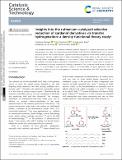Files in this item
Insights into the ruthenium-catalysed selective reduction of cardanol derivatives via transfer hydrogenation : a density functional theory study
Item metadata
| dc.contributor.author | Ahmad, Shahbaz | |
| dc.contributor.author | Crawford, Ellis | |
| dc.contributor.author | Bilal, Muhammad | |
| dc.contributor.author | de Vries, Johannes G. | |
| dc.contributor.author | Buehl, Michael | |
| dc.date.accessioned | 2023-03-08T12:30:10Z | |
| dc.date.available | 2023-03-08T12:30:10Z | |
| dc.date.issued | 2023-05-07 | |
| dc.identifier | 283549178 | |
| dc.identifier | d18c4a67-8752-4997-bef6-24ce4ba5800a | |
| dc.identifier | 85149968007 | |
| dc.identifier.citation | Ahmad , S , Crawford , E , Bilal , M , de Vries , J G & Buehl , M 2023 , ' Insights into the ruthenium-catalysed selective reduction of cardanol derivatives via transfer hydrogenation : a density functional theory study ' , Catalysis Science & Technology , vol. 13 , no. 9 , pp. 2662-2674 . https://doi.org/10.1039/D3CY00135K | en |
| dc.identifier.issn | 2044-4753 | |
| dc.identifier.other | ORCID: /0000-0002-1095-7143/work/130204215 | |
| dc.identifier.uri | https://hdl.handle.net/10023/27128 | |
| dc.description | Funding: Authors thank EaStCHEM and the School of Chemistry for their support. | en |
| dc.description.abstract | The detailed mechanism for ruthenium-catalysed selective reductionof cardanol derivatives by transfer hydrogenation has been fully characterisedat the B3PW91-D3/ECP2/PCM//B3PW91/ECP1 level of density functional theory. The explored catalytic cycle involved the hydrogenation of the triene cardanolgiving the diene product through a highly stable η3-allylicintermediate via a kinetic barrier of 29.1 kcal mol−1, which followed further hydrogenation leading to a more stable η3-allylicintermediate. The further reduction to the cardanol monoene product required an overall barrier of 29.2 kcal mol−1, which offers a rationale for the requirement of elevated temperatures (refluxing isopropanol). The computed overall barrier of 46.6 kcal mol−1 to accommodate a fully saturated product is unsurmountable— in good agreement with the experiment, where no such full hydrogenation is observed, and rationalising the 100% selectivity towards the monoene product. | |
| dc.format.extent | 13 | |
| dc.format.extent | 2868472 | |
| dc.language.iso | eng | |
| dc.relation.ispartof | Catalysis Science & Technology | en |
| dc.subject | DFT | en |
| dc.subject | Hydrogenation | en |
| dc.subject | Homogeneous catalysis | en |
| dc.subject | Selective reduction | en |
| dc.subject | Transfer hydrogenation | en |
| dc.subject | QD Chemistry | en |
| dc.subject | DAS | en |
| dc.subject | MCC | en |
| dc.subject.lcc | QD | en |
| dc.title | Insights into the ruthenium-catalysed selective reduction of cardanol derivatives via transfer hydrogenation : a density functional theory study | en |
| dc.type | Journal article | en |
| dc.contributor.institution | University of St Andrews. EaSTCHEM | en |
| dc.contributor.institution | University of St Andrews. School of Chemistry | en |
| dc.identifier.doi | 10.1039/D3CY00135K | |
| dc.description.status | Peer reviewed | en |
This item appears in the following Collection(s)
Items in the St Andrews Research Repository are protected by copyright, with all rights reserved, unless otherwise indicated.

